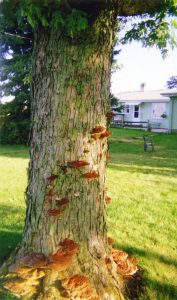 Q. Enclosed photo is of a soft maple about 50-55 years of age. These brownish growths began a few years ago but were much smaller and fewer. This year they seem to have multiplied by 10 times. I’m sure the tree is doomed. Three soft maples were in our yard when we moved in 45 years ago. Will the other two become infected? – R.W., Crawfordsville, Ind.
Q. Enclosed photo is of a soft maple about 50-55 years of age. These brownish growths began a few years ago but were much smaller and fewer. This year they seem to have multiplied by 10 times. I’m sure the tree is doomed. Three soft maples were in our yard when we moved in 45 years ago. Will the other two become infected? – R.W., Crawfordsville, Ind.
A. The good news is that the brown growths are not contagious! These mushroom growths out of the trunk are called conks or shelf fungi and are among nature’s many recyclers. They grow on decaying wood within the tree. The bad news is that the presence of wood-decaying fungi is indicative of serious internal decay, which likely has been ongoing for quite some time in this tree. Soft maples are rather prone to limb breakage, poor branch angles, canker disease and other issues that foster internal decay. The conks will not “spread” to other healthy trees, but they can occur on any decaying tree.
There is no need to “control” this fungus. Attempts to do so would be futile and do not address the underlying problem. As for whether or not the tree is doomed, it is difficult to say how soon, but the fact that the conks are most prominent at the base of the tree indicates advanced decay low in the trunk. So I’d say the long-term prognosis is not good. Minimizing other stress to the tree going forward can help prolong its life, but you should assess the degree of risk posed by such a tree dropping branches and possibly splitting at the trunk in future storms, posing potential hazard to people and property. A professional arborist can conduct a risk assessment and provide bids for tree removal, if needed.
More information on wood-decaying fungi in trees is available from the Purdue Plant & Pest Diagnostic Lab.
See the Purdue Extension publication Tree Risk Assessment for additional information.